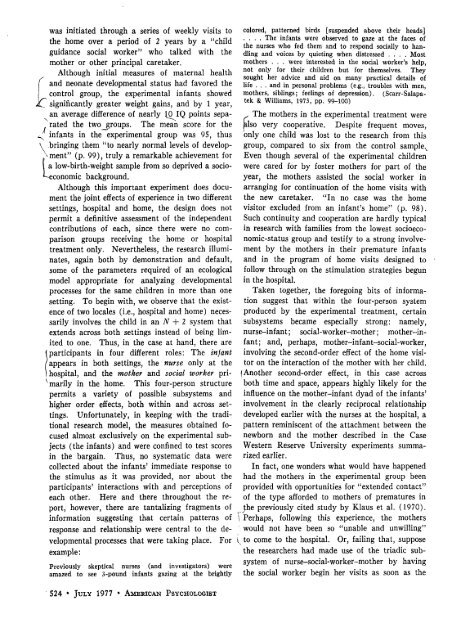Bronfenbrenner 1977
You also want an ePaper? Increase the reach of your titles
YUMPU automatically turns print PDFs into web optimized ePapers that Google loves.
was initiated through a series of weekly visits to<br />
the home over a period of 2 years by a "child<br />
guidance social worker" who talked with the<br />
mother or other principal caretaker.<br />
Although initial measures of maternal health<br />
and neonate developmental status had favored the<br />
control group, the experimental infants showed<br />
significantly greater weight gains, and by 1 year,<br />
an average difference of nearly 10 IQ points separated<br />
the two_groups. The mean score for the<br />
^ infants in the experimental group was 95, thus<br />
\ bringing them "to nearly normal levels of develop-<br />
.^ment" (p. 99), truly a remarkable achievement for<br />
I a low-birth-weight sample from so deprived a socio-<br />
L-economic background.<br />
Although this important experiment does document<br />
the joint effects of experience in two different<br />
settings, hospital and home, the design does not<br />
permit a definitive assessment of the independent<br />
contributions of each, since there were no comparison<br />
groups receiving the home or hospital<br />
treatment only. Nevertheless, the research illuminates,<br />
again both by demonstration and default,<br />
some of the parameters required of an ecological<br />
model appropriate for analyzing developmental<br />
processes for the same children in more than one<br />
setting. To begin with, we observe that the existence<br />
of two locales (i.e., hospital and home) necessarily<br />
involves the child in an N + 2 system that<br />
extends across both settings instead of being limited<br />
to one. Thus, in the case at hand, there are<br />
(participants in four different roles: The infant<br />
/appears in both settings, the nurse only at the<br />
I hospital, and the mother and social worker pri-<br />
''marily in the home. This four-person structure<br />
permits a variety of possible subsystems and<br />
higher order effects, both within and across settings.<br />
Unfortunately, in keeping with the traditional<br />
research model, the measures obtained focused<br />
almost exclusively on the experimental subjects<br />
(the infants) and were confined to test scores<br />
in the bargain. Thus, no systematic data were<br />
collected about the infants' immediate response to<br />
the stimulus as it was provided, nor about the<br />
participants' interactions with and perceptions of<br />
each other. Here and there throughout the report,<br />
however, there are tantalizing fragments of<br />
information suggesting that certain patterns of<br />
response and relationship were central to the developmental<br />
processes that were taking place. For<br />
example:<br />
Previously skeptical nurses (and investigators) were<br />
amazed to see 3-pound infants gazing at the brightly<br />
524 • JULY <strong>1977</strong> • AMERICAN PSYCHOLOGIST<br />
colored, patterned birds [suspended above their heads]<br />
.... The infants were observed to gaze at the faces of<br />
the nurses who fed them and to respond socially to handling<br />
and voices by quieting when distressed .... Most<br />
mothers .. . were interested in the social worker's help,<br />
not only for their children but for themselves. They<br />
sought her advice and aid on many practical details of<br />
life . . . and in personal problems (e.g., troubles with men,<br />
mothers, siblings; feelings of depression). (Scarr-Salapatek<br />
& Williams, 1973, pp. 99-100)<br />
, The mothers in the experimental treatment were<br />
plso very cooperative. Despite frequent moves,<br />
only one child was lost to the research from this<br />
group, compared to six from the control sample v<br />
Even though several of the experimental children<br />
were cared for by foster mothers for part of the<br />
year, the mothers assisted the social worker in<br />
arranging for continuation of the home visits with<br />
the new caretaker. "In no case was the home<br />
visitor excluded from an infant's home" (p. 98).<br />
Such continuity and cooperation are hardly typical<br />
in research with families from the lowest socioeconomic-status<br />
group and testify to a strong involvement<br />
by the mothers in their premature infants<br />
and in the program of home visits designed to<br />
follow through on the stimulation strategies begun<br />
in the hospital.<br />
Taken together, the foregoing bits of information<br />
suggest that within the four-person system<br />
produced by the experimental treatment, certain<br />
subsystems became especially strong: namely,<br />
nurse-infant; social-worker-mother; mother-infant;<br />
and, perhaps, mother-infant-social-worker,<br />
involving the second-order effect of the home visitor<br />
on the interaction of the mother with her child.<br />
[Another second-order effect, in this case across<br />
both time and space, appears highly likely for the<br />
influence on the mother-infant dyad of the infants'<br />
involvement in the clearly reciprocal relationship<br />
developed earlier with the nurses at the hospital, a<br />
pattern reminiscent of the attachment between the<br />
newborn and the mother described in the Case<br />
Western Reserve University experiments summarized<br />
earlier.<br />
In fact, one wonders what would have happened<br />
had the mothers in the experimental group been<br />
provided with opportunities for "extended contact"<br />
of the type afforded to mothers of prematures in<br />
the previously cited study by Klaus et al. (1970).<br />
} Perhaps, following this experience, the mothers<br />
would not have been so "unable and unwilling"<br />
v to come to the hospital. Or, failing that, suppose<br />
the researchers had made use of the triadic subsystem<br />
of nurse-social-worker-mother by having<br />
the social worker begin her visits as soon as the


